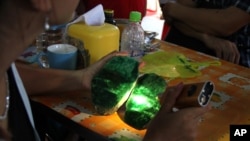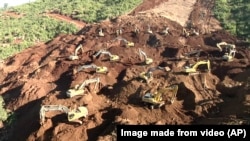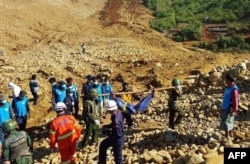Within days of the start of the monsoon rains, the dangerous conditions and lack of safety measures at Myanmar’s jade mines were highlighted when a dozen miners were killed while scavenging in a mining pit.
The area in Hpakant Township, in northern Myanmar’s Kachin State, is a vast wasteland of deep pits and huge rubble heaps produced by mining companies using heavy machinery and dynamite.
Heavy rains often increase instability in the area, and on Monday a pit wall collapsed on scores of workers, said Khin Maung Myint, a National League for Democracy (NLD) Upper House parliamentarian from Hpakant.
“They found 12 bodies so far and sent 50 to the hospital,” he said, adding he believed up to 100 men could still be under the rubble. “There is heavy raining so they had to stop searching,”
He added that the men had illegally entered a company pit where work was suspended.
Deadly accidents are common in the Hpakant mines, where poor migrants from across Myanmar scavenge mining waste and pits for jade stones.
On May 8, 13 people reportedly died in a landslide. Several accidents with a lower death toll occurred in December and January. In one of the worst accident in recent memory, 114 men sleeping in a mining camp died when they were crushed by a collapsing waste mound last November.
300,000 miners, no safety measures
In 2015, an estimated 300,000 itinerant miners were scavenging for jade in Hpakant, a recent state media article said. It noted there had been a sharp rise in workers in the past few years, along with an increase in large-scale mining and waste dumping.
Naw Lown, secretary of the Kachin National Development Foundation, said the hazardous conditions were created by powerful, licensed companies that dumped waste with no regard for safety regulations or environmental rules.
“They don’t take responsibility, they care only for their benefits. They don’t explore according to the rules and regulations, and they don’t dump waste in a systematic way,” he said.
Authorities have thus far struggled to enforce safety laws, or to control the masses of itinerant miners, a situation that the new NLD government urgently wants to change. It has announced plans to improve mine safety during its first 100 days in office and will issue no new mining license until new rules and environmental safeguards are in place.
“We… will make arrangements for systematic mining there,” Win Htein, director-general of the Mining Department, told state media on May 19. Measures such as moving at-risk camps of miners, creating safe zones and enforcing tighter rules on dumping are being planned.
Khin Maung Myint said there were around 150 firms extracting jade, adding that NLD officials “want to stop all mining during the rainy season because it’s dangerous, but that’s very difficult because there are interests (of companies) owned by the military.”
Dreams, drugs and danger
Living conditions in the remote, mountainous area are tough and most workers share simple shacks set up in dirty camps. Addiction to drugs such as heroin and opium, which are cheap and produced in northern Myanmar, is common.
Yet income levels are good by Myanmar standards as workers can earn $300 per month or more. This attracts migrants who are willing to take great risks.
Khin Maung Myint said many are driven by the hope of finding a large jade stone. “They dream they can find a golden pot at the end of the rainbow,” he said, adding that most migrants come from impoverished, crisis-affected Rakhine State
Reverend Sai Naw of the Baptist Church in Hpakant said many laborers simply work to feed their drug addiction. “The main danger for miners is the landslide, but we estimate that 60 percent of the migrant miners use drugs, though there is no detailed or correct data,” he said, adding that the recent opening of a NGO health clinic providing free clean needles would help reduce the spread of HIV/AIDS.
While countless poor men toil in dangerous conditions and scores die, the owners of mining companies are reaping huge profits.
The jade sector is believed to be Myanmar’s most valuable industry, with an estimated worth of as much as $31 billion annually, according to an investigation by the London-based natural resource watchdog Global Witness. It found most mining firms had military connections and hid their ownership and license contracts.
Jade is highly prized in China and most is exported as unregistered raw blocks across the nearby border, from where it goes to Hong Kong for processing.











